50 issues of Uncrewed Systems Technology Special review
Special review
Our first cover dossier was on the Penguin C, which was a
contemporary of early successful UAVs such as the InsituScanEagle and AAI Aerosonde (Courtesy of UAV Factory, now Edge Autonomy)
Rory Jackson looks at some of the key trends in uncrewed systems covered in our first 50 issues, and points to others that could emerge in the future
Alti’s Transition on the other hand uses four fixed, vertically oriented rotors installed on twin booms (which run backwards into an inverted vee-tail) combined with a rear-mounted pusher prop. That has become one of the most widely adopted configurations among UAV manufacturers.
Both companies are still operating. Alti UAS has since launched the Reach, a larger variation on the Transition with double the wingspan (6 m rather than 3) and an upscaled powertrain, making it capable of more than 10 hours of endurance and 150 km of range compared to the Transition’s 8 hours and 50 km.
Wingcopter meanwhile now offers the 198 UAV, so-called for its wingspan in centimetres, as was its predecessor. The 198 measures 152 cm long and has a
6 kg payload capacity, and now flies using eight motors – four tiltrotors, four fixed and vertically oriented rotors – all powered by 1.6 kWh of lithium-ion batteries.
There are many reasons why VTOL-transitioning UAV companies began springing up and flourishing from 2015 onwards. In addition to electromechanics and autopilots advancing enough to handle the computationally intensive transition between hovering and flight, they give the ability to land in and take off from small spaces.
That meant for instance that forest clearings for disaster relief operators, parking lots for logistics organisations, or helicopter pads (or even tighter spots) on oceangoing vessels could now be served by uncrewed aircraft. It also meant no more lengthy pre-launch maintenance and checklists required for crewed helicopters, along with all the associated costs of such larger vehicles.
With so many use cases, demand very rapidly drove the inception of entirely new aircraft designs that were very unlike anything else. In mid-2017 (issue 15, August/September) we met up
with Martin UAV (now Shield AI, which acquired the company in 2021) to discuss its V-Bat, still one of the only engine-powered tailsitters.
The tailsitter configuration had effectively been discontinued in crewed aviation after multiple failed attempts during the 20th century to engineer and pilot them.
However, the V-Bat’s use of a ducted fan for thrust, as well as robust control algorithms to use modern air data and inertial sensor technology with a high update rate meant it could pull off the challenging manoeuvres necessary for launching and landing such vehicles.
This not only marked the first time uncrewed systems had resurrected
a ‘dead’ aircraft type, but also found vital uses for it in the world. As a result, the V-Bat continues to win awards and contracts for service, particularly in maritime defence applications.
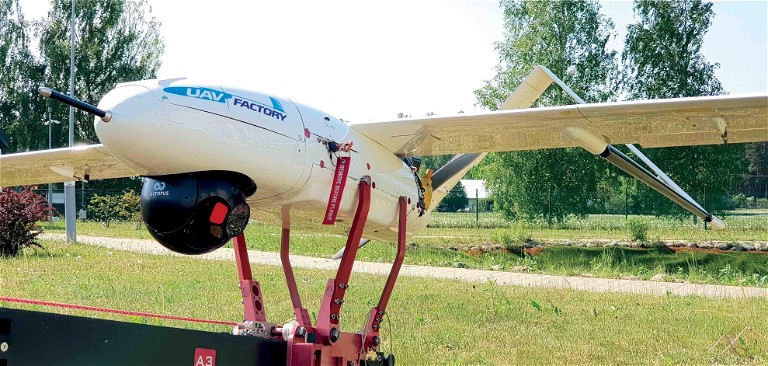
Our first cover dossier was on the Penguin C, which was a contemporary of early successful UAVs such as the Insitu ScanEagle and AAI Aerosonde
(Courtesy of UAV Factory, now Edge Autonomy)
In the words of Dr Donough Wilson in our inaugural issue, in November 2014, “There are no rules.” It’s a stance echoed by our editorial director Ian Bamsey to describe the scope for fresh ideas and uninhibited engineering across the world of uncrewed systems.
That was in 2014, at a time when seminal uncrewed vehicle programmes such as the Insitu ScanEagle, AAI Aerosonde and Kongsberg Hugin had begun inspiring a multitude of other companies around the world to explore this new frontier of technology. And indeed, the industry was very much a global one by this point – that first issue featured a Latvian UAV, a German engine, a British USV and an American HAPS.
This magazine’s founders were eager to explore this emerging industry and the new technologies and ideas it might bear. As with any new frontier technology industry however, they naturally had some trepidation that a crash, consolidation or other contractions in the industry could also come within the following few years, putting a damper on the number of companies and innovations worth reporting on in these pages.
Fortunately, even their most pessimistic projections failed to come true. In the 10 years since we started documenting the technical achievements of the autonomous systems world, thousands of new companies and products have been spawned, bringing myriad new perspectives and ideas for advancing the technology.
Even outsiders taking cursory glances at this vibrant industry can feel overwhelmed at all the new strains of electronics, avionics, powertrains, software solutions and more critical subsystems that have been rethought in unprecedented ways, with the specific purpose of providing uncrewed vehicles with new levels of intelligence and reliability.
Given all of these, and the many autonomous vehicle missions and classes that have emerged, we have chosen to use this occasion of our 50th issue to take a short look back and recount some of the key trends and evolutions in uncrewed systems and technologies that have defined this past decade the most.
VTOL-transitioning aircraft
Before 2014, our founders researched the industry and saw two particular features defining how the shape of the uncrewed world could potentially change in the years ahead. The first was that our pages would be almost exclusively UAVs – our first cover story having been on the catapult-launched Penguin C UAV from UAV Factory, now Edge Autonomy – as back then, the uncrewed world was indeed heavily dominated by UAVs. Growth in UAV engineering and manufacturing, many expected, would eclipse all other uncrewed vehicle types.
It hasn’t turned out like that though, and we have in fact featured hundreds of professionally designed UGVs, UUVs and USVs in detail over the past 10 years. But their core instincts were right in that UAVs remain a hallmark of the industry and a focal point for much of its innovation. Naturally, if something is small, light and energy-efficient enough to work in a UAV, it will fit the SWaP-constraints of most other vehicle types.
With so much innovation in UAVs, a few major trends are easy to notice. The most visible of these is the rise of VTOLtransitioning architectures, which have gone from serving a rare niche to becoming a common sight at every UAV expo.
Although the first VTOL-transitioning UAV we featured in detail was the Alti Transition (issue 8, June/July 2016), our first discussions about doing so were actually with Wingcopter. That eventually bore fruit in the form of our cover story on its Wingcopter 178 UAV in issue 24 (February/March 2019).
These two early cases showcased two quite different approaches to the problem of combining fixed-wing flight with a VTOL and hovering capability. In the German UAV, a quad-tiltrotor mechanism was developed in which each tiltrotor used a servo actuator to move its motor/prop-rotor pod by 90o.
Alti’s Transition on the other hand uses four fixed, vertically oriented rotors installed on twin booms (which run backwards into an inverted vee-tail) combined with a rear-mounted pusher prop. That has become one of the most widely adopted configurations among UAV manufacturers.
Both companies are still operating. Alti UAS has since launched the Reach, a larger variation on the Transition with double the wingspan (6 m rather than 3) and an upscaled powertrain, making it capable of more than 10 hours of endurance and 150 km of range compared to the Transition’s 8 hours and 50 km.

VTOL-transitioning has grown from being a rare niche in tiltrotors such as the Wingcopter 178
(Courtesy of Wingcopter)…
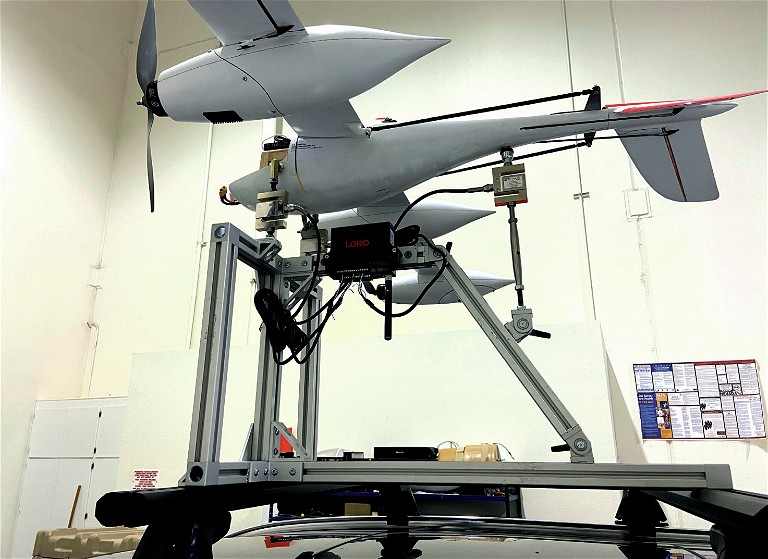
…to being widespread among uncrewed aircraft designs, sparking unique creations such as the Transwing UAVs from Pterodynamics
(courtesy of Pterodynamics)
Wingcopter meanwhile now offers the 198 UAV, so-called for its wingspan in centimetres, as was its predecessor. The 198 measures 152 cm long and has a 6 kg payload capacity, and now flies using eight motors – four tiltrotors, four fixed and vertically oriented rotors – all powered by 1.6 kWh of lithium-ion batteries.
There are many reasons why VTOLtransitioning UAV companies began springing up and flourishing from 2015 onwards. In addition to electromechanics and autopilots advancing enough to handle the computationally intensive transition between hovering and flight, they give the ability to land in and take off from small spaces.
That meant for instance that forest clearings for disaster relief operators, parking lots for logistics organisations, or helicopter pads (or even tighter spots) on oceangoing vessels could now be served by uncrewed aircraft. It also meant no more lengthy pre-launch maintenance and checklists required for crewed helicopters, along with all the associated costs of such larger vehicles.
With so many use cases, demand very rapidly drove the inception of entirely new aircraft designs that were very unlike anything else. In mid-2017 (issue 15, August/September) we met up with Martin UAV (now Shield AI, which acquired the company in 2021) to discuss its V-Bat, still one of the only enginepowered tailsitters.
The tailsitter configuration had effectively been discontinued in crewed aviation after multiple failed attempts during the 20th century to engineer and pilot them.
However, the V-Bat’s use of a ducted fan for thrust, as well as robust control algorithms to use modern air data and inertial sensor technology with a high update rate meant it could pull off the challenging manoeuvres necessary for launching and landing such vehicles.
This not only marked the first time uncrewed systems had resurrected a ‘dead’ aircraft type, but also found vital uses for it in the world. As a result, the V-Bat continues to win awards and contracts for service, particularly in maritime defence applications.
Although navies and air forces have particularly stringent requirements for their UAVs, the V-Bat’s ducted fan powertrain configuration gives it a sizeable lifting capacity – 11.34 kg of payload out of a 57 kg MTOW is typical – as well as a 10 hour flight endurance or 45 minutes of hover. Add to that its ability to perform VTOL in any 3.65 x 3.65 m space (as landing on its tail minimises its ground profile) and the result is an aerial surveillance tool capable of stationary hovering that can be used in a far wider variety of vessels than any crewed helicopter.
In more recent times, Pterodynamics has gone further than exploring history’s forgotten aircraft designs, by inventing an entirely new one instead. Its Transwing series of UAVs were built with a unique transverse folding wing that made transitioning mechanically simple (with a single linear actuator responsible for the folding) and computationally simple, with effectively a sliding scale between the flight logic of a hovering UAV and that of a fixed-wing UAV.
This aircraft has also been tapped for use by naval vessels, particularly in ship-to-ship or ship-to-shore logistics, and such is the importance of lifting heavy loads in this application that since our feature on Pterodynamics (issue 41, December 2021/January 2022) the company has announced plans for two larger variations of its flagship, the allelectric 38 kg MTOW X-P4.
The variants are the upcoming hybridelectric X-P5, which will weigh 150 kg when fully loaded and carry 22.67 kg payloads, and the X-P6, which will be powered by a turbo-generator, have a 600 kg MTOW, and lift up to 100 kg of payload per flight. It will also be the fastest aircraft the company builds, with an estimated 120 knots compared to the 100 knots typical of the X-P4 and expected of the X-P5, as well as having an 850 nautical mile range when fully loaded.
All of that is not to say VTOL-transitioning UAVs are a one-size-fits-all solution. Landing vertically with a set of wings makes them more prone to being blown off-course by gusts than multi-rotors, and the added moving parts – be they tiltrotors or fixed-lift motors – will inevitably look like little more than additional points of failure to riskaverse technicians.
Multi-rotor, STOL and catapult-launched UAVs are therefore still widely used in a range of military, commercial and other applications, and their operations have undoubtedly grown. But no other corner of the aviation world features VTOLtransitioning anywhere near as much as uncrewed systems do, marking this group of technologies as one of the most prominent features that historians of this industry will probably point to.
AI on land and sea
The first forays by this publication into UGVs were tentative. Initially, we investigated only exploratory projects in uncrewed mining and farming, as well as the occasional autonomous pod taxi or self-driving test and research vehicle, such was the less mature nature of UGV technology from 2014 to 2016 relative to UAVs.
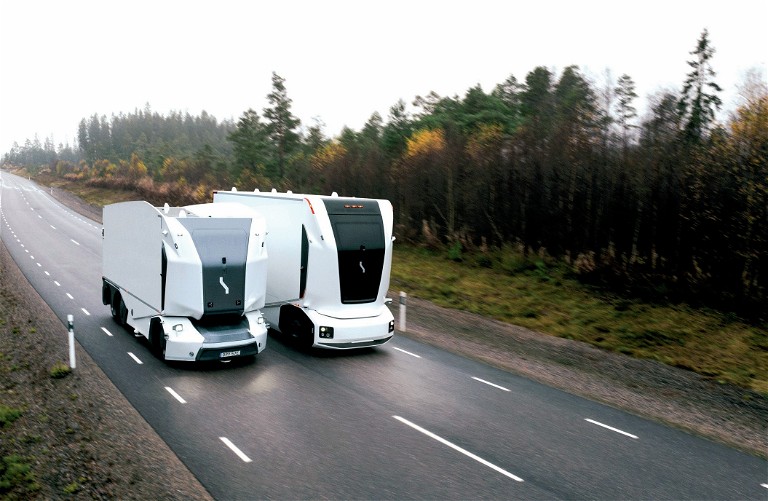
UGVs have become increasingly safe and successful when operating on roads, thanks to great improvements in AI unlocking higher levels of self-driving intelligence
(Courtesy of Einride)
The past few years however have seen an enormous surge in the number of successful UGV OEMs, especially in logistics. Companies such as Einride and Starship Technologies (both featured in issue 37, April/May 2021) received global mainstream media attention for their vehicles – the former being a 26 t road freight hauler, the latter a 20 kg robot for kerbside food deliveries.
Despite the complexity and potential dangers of trusting an autonomous system to deliver goods amid people or road vehicles, a lot of companies are now developing very different solutions for handling freight and throughput, while navigating different kinds of traffic.
The Clevon 1 for instance (issue 47, December 2022/January 2023) is a 470 kg last-mile delivery vehicle being used by DHL and others for transporting loads of 150 kg at a time by road, whereas Kodiak’s Gen4 (issue 48, February/March 2023) is an 18-wheeler capable of moving shipping containers autonomously across America’s highways, and Ottonomy’s Ottobot (issue 49, April/May 2023) is designed to deliver food or groceries through streets or airport terminals (GNSS being unsuitable in both cases).
Part of this success has come from tandem advances in hardware and software for navigation solutions beyond pure reliance on GNSS. By being almost always closer to the ground than UAVs, UGVs must typically travel through urban canyons and hence need more than GNSS to reach their objectives and recovery points without issue.
The availability of visual SLAM has been widened greatly by the proliferation of online libraries and open-source algorithms for training UGVs’ main computers to detect and classify key objects in the context of the environments through which they have to navigate, such as pedestrians, charging points or other vehicles.
At the same time, the advent of computer platforms designed specifically with vehicular AI in mind has enabled widespread access to the levels of CPU, GPU and FPGA hardware necessary for such intelligence, and for complex decision-making to be performed at speeds necessary for obstacle avoidance or safe braking at speed.
Both of these have also been assisted by the greater supply and capabilities of 3D Lidar across the industry.
The Ottobot for instance primarily uses 3D Lidar for geometric details on surrounding objects, as well as cameras for the semantic information that is key to context-based identification and specification of those objects. It can therefore localise itself using those specifications in the case of fixed objects, or predict how they might move during certain avoidance paths to be taken if they were moving objects.
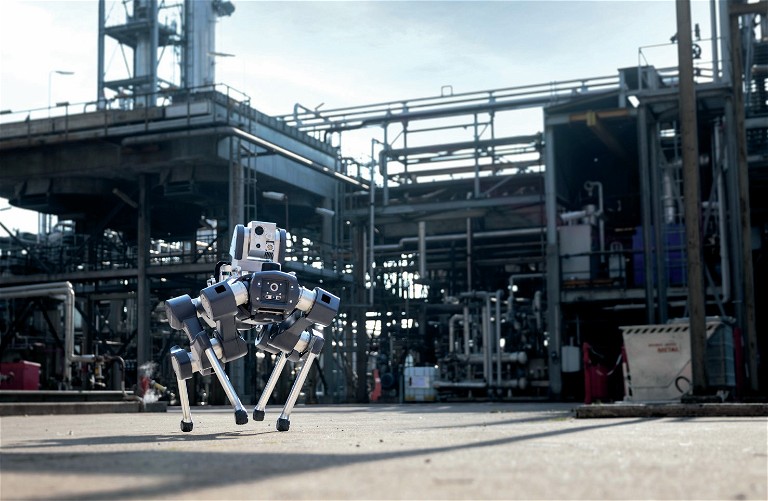
Autonomy without GNSS has been another major hallmark of the past decade, with UGVs such as the ANYmal able to navigate smoothly whether indoors or outdoors
(Courtesy of ANYbotics)
Like the Ottobot, the Kodiak Gen4 uses very little GNSS, despite it always being outdoors and generally far from urban canyons, and instead navigates primarily using its sensors to recognise lanes in the surrounding roads. That is enough for localisation and mapping once an initial GNSS fix upon start-up indicates which road the truck is situated on.
Of course, terrestrial vehicles are not the only ones that need GNSS-free navigation, detailed object recognition and the intelligence to act on them. UUVs in particular always have to navigate without GNSS, and cannot have a human make decisions for them remotely. And although underwater SLAM and AI had been theorised about for years before our first issue, major breakthroughs have been made only in recent times.
Take for instance the Sunfish AUV (issue 35, December 2020/January 2021), which uses its SLAM to explore and map labyrinthine areas such as underwater caves and plumes in an entirely unassisted and repeatable fashion. It does not need any preprogrammed waypoints, and always returns seamlessly to its deployment location near the end of its 10 hour battery life.
And in issue 47, BeeX discussed its A.IKANBILIS UUV with us, which uses what the company calls “adaptive autonomy” to recognise, zoom in on and search around key points of interest on wind farm foundations. That way, the underwater robot can ‘realise’ where its end-users will want additional sonar and camera imagery taken, and capture them on the spot, rather than having to be deployed for a second outing after the first round of data has been analysed.
The essence of both of these underwater use cases can also be seen in the growing wave of quadrupedal inspection UGVs, such as the ANYbotics ANYmal (issue 40, October/November 2021, and revisited briefly in issue 49 (April/May 2023). This vehicle (and others like it) uses SLAM to navigate through potentially unsafe indoor environments such as offshore oil rigs and mining tunnels, with additional AI software being critical not only to it recognising and inspecting signs of damage, but also to the very way in which it walks on four legs, enabling it to climb stairs and right itself after suffering an impact.
With AI now empowering uncrewed systems to react so intelligently to fine details in their surroundings, the next phase of operating capabilities for such robots is represented by companies such as Nautilus Robotics (discussed briefly in issue 48,) whose large UUV features manipulator arms for interacting with subsea infrastructure.
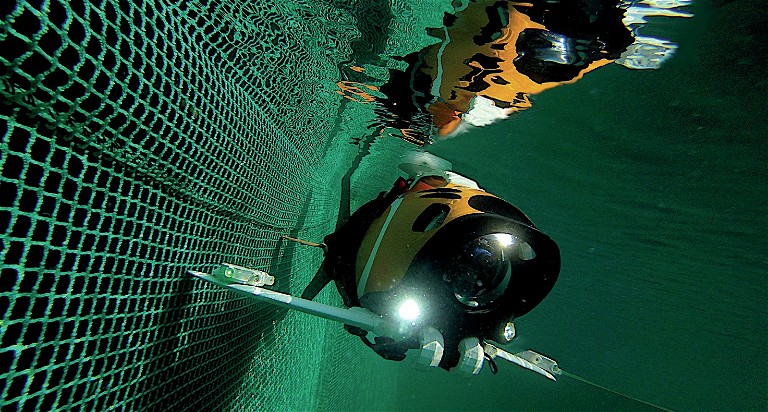
Uncrewed systems are increasingly a staging ground for biomimetics, such as Aquaai’s Mazu AUV, which flexes and swims like a fish
(Courtesy of Aquaai)
In the near future, quadrupedal UGVs are expected to be similarly coupled with arms for autonomously opening doors or manipulating valve wheels. And if the reach of their arms proves to be an issue, a subsequent generation of bipedal UGVs can be expected, as a more distant but probably inevitable direction the industry will head towards, to add to the ability of autonomous systems to take the place of people in dangerous working areas.
While few companies are currently capable of bipedal autonomy, the pace of advances in processors, inertial systems and navigation using visual or Lidar sensing is such that development of such robots will become easier and more accessible to companies everywhere in due course.
And as robotic vehicles take on the qualities of biological life on land, so UUVs that resemble aquatic creatures have started appearing in the mainstream media. Aquaai’s Mazu UUV (issue 39, August/September 2021) for example has the outward appearance of a fish to blend in among farmed salmon schools, as well as the locomotion of one to enhance its energy efficiency and navigation stability.
Materials science advances are already (and will continue to be) vital to optimising hydrodynamics and ruggedness for such soft robots as they are used beyond fish farms, throughout the world’s lakes and oceans to better understand and protect marine life as environmental safeguarding takes primacy among global priorities.
Heavy fuel
One cannot discuss environmental considerations without also thinking about power and energy, and the uncrewed world’s relationship with them.
As mentioned, this magazine’s founders’ first exploratory research rounds found that the industry was heavily dominated by UAVs – they also found that just six or seven engine companies were showcasing UAV powertrains at that time. They therefore logically expected that we might need to return to each of those companies for a feature-length engine dossier every year or two.
But not only are there more than six or so UAV engine companies – we have since investigated 44 that produce either IC powertrains or hydrogen fuel cells for uncrewed systems – we have also visited six of those twice, unpacking their experiences gained after a 5-6 year stint since our first in-depth coverage.
When looking across all these companies, one can see that the uncrewed engine industry reflects changes in the automotive world. There is a great push for fuel efficiency, as manifested in some major trends in how UAV powertrains have evolved. One is centred on heavy fuel, which is valued for its safety and efficiency by naval and other maritime operators.
This was hinted at in our first issue, with Hirth’s S1218 engine capable of running on gasoline or heavy fuels, and subsequent issues have covered other multi-fuel engines (Wankels, for instance, which can often run on heavy fuels).
But over the past 3 years, our industry has seen a boom in engines that are engineered not just for mere compatibility with heavy fuels but optimised to run on them primarily or even exclusively. Hirth, for instance, welcomed us back for our 36th issue (February/March 2021) to show us its 3507-01M liquid-cooled, direct-injection heavy fuel engine, as well as its 4202, an architectural descendant of the S1218 designed with special features to prevent operational hazards such as heavy fuel ‘puddling’ and knocking.
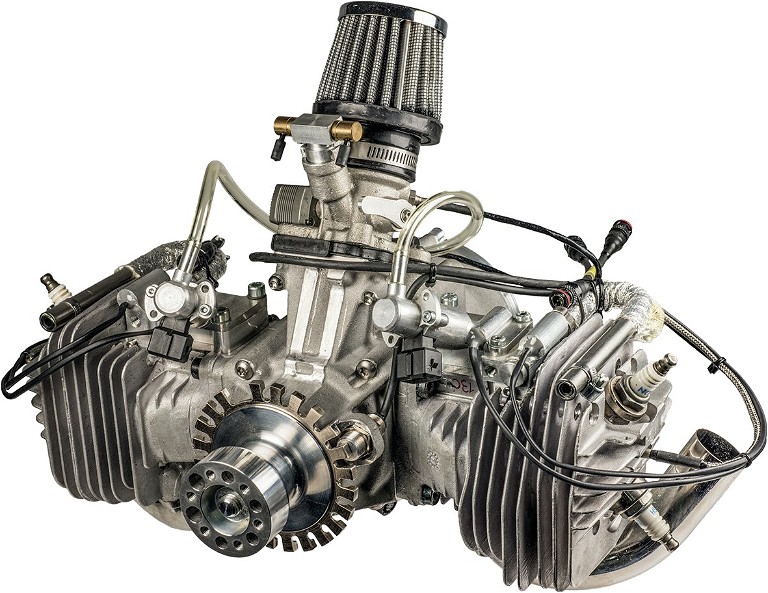
The Hirth 4202HF (shown here with one of its early iteration) is an evolution
(Courtesy of Hirth)
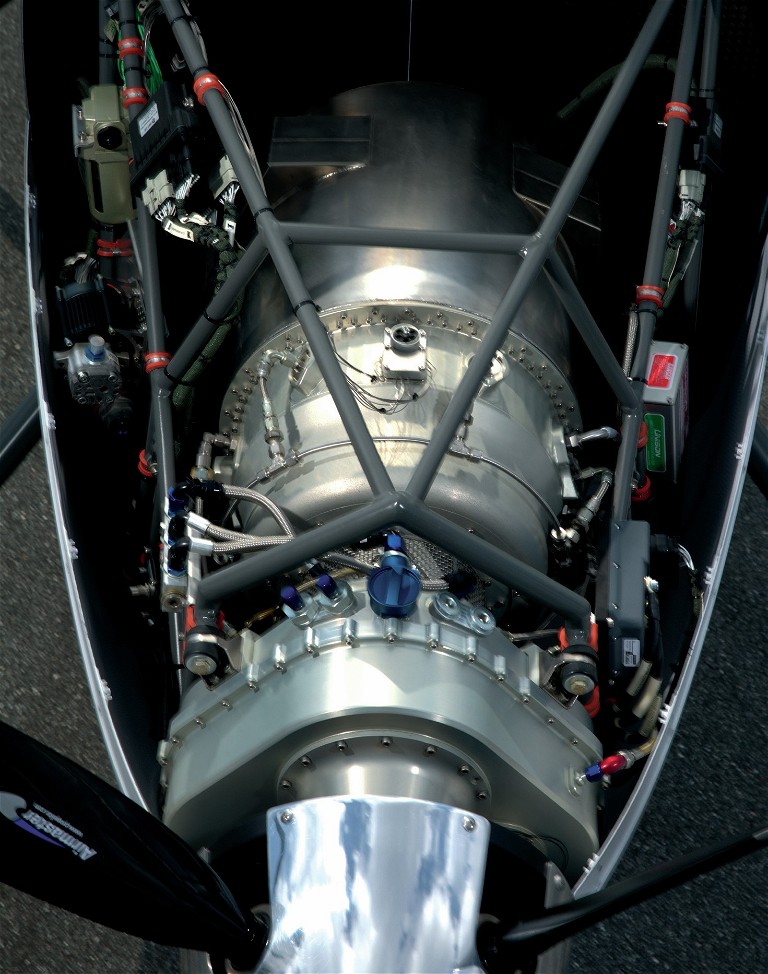
Fuel efficiency and long life between TBOs were major factors driving Aergility’s choice of Turbotech’s recuperated turboprop engine
(Courtesy of Aergility)
Similarly, we revisited Cobra Aero in issue 44 (June/July 2022), 5 years after covering its A33i single-cylinder, spark-ignited gasoline engine, to detail its new triple-inline cylinder A99H – in some ways a successor to the A33i, but again, optimised for using heavy fuels as its primary source of power. The A99H also incorporates some advances made during 2017-22, such as metal additive manufacturing and critical improvements in its ECU programming.
Such is the importance of UAVs and other uncrewed systems to next-generation naval strategies and investments that we cannot imagine a future in which more companies do not come forward with robust and efficient heavy fuel engines. A few others have such solutions in development, although we have not featured them yet.
Hybrid powertrains
Both Hirth and Cobra Aero (among many others) have expressed to us a strong interest in hybridisation. Some of the reasons for this are similar to those in the automotive world. If electrical power output is more important than shaft power, then an engine can be run at its most fuel-efficient speed at intermittent points when a battery needs to be recharged, rather than having it ever idle or run near its redline.
However, unlike road vehicles, UAVs face a dilemma regarding flight endurance. Users want more uptime in their autonomous systems, and the scale of their demand is now beyond that which batteries can deliver, or will feasibly deliver, unless recent trends in gravimetric energy density can be bucked. Certainly, battery technologies are emerging with higher and higher specific energy to aid their use in UAVs, but too often that comes with drawbacks to do with discharge rates and other performance factors.
As fuels provide far higher specific energy than batteries, hybrid powertrains are vital to unlocking flight times longer than an hour for small, professional multi-rotors, and upwards of say 4 or 5 hours for small and otherwise all-electric fixed-wing systems.
There are a few trends in existing hybrid power units, such as that integrated into Xer Technologies’ X12 hybrid multi-rotor (issue 44). Xer’s proprietary solution for instance took considerable focus on cooling, vibration damping and stable power management for it to work safely on its flagship UAV.
Managing qualities such as these has been similarly important among hybrid powertrains of all sizes throughout the UAV world, such as Pegasus Aeronautics’ 4 kW GE70 (issue 20, June/July 2018), or Sky Power’s 22 kW SP-180 hybridised Wankel (issue 25, April/May 2019) and the larger variations of this solution the company has unveiled since.
Further innovations can be seen outside these trends that still form part of the overall push to make UAVs more fuel-efficient. For instance, our 31st issue (April/May 2020) included a detailed investigation of Turbotech’s microturbine engines – one a turboprop, the other a hybrid turbo-generator, but both using similar engineering.
Although microturbines typically achieve a fuel efficiency of around 10%, Turbotech devised a system to recuperate otherwise-wasted exhaust heat. That greatly reduces the amount of fuel needed to heat and pressurise its charge air to drive its turbine at 80,000 rpm, and raises its fuel efficiency to a more respectable 30% – arare achievement among microturbines.
Such technology is being validated throughout the industry. For instance, Aergility has chosen Turbotech’s engine for its Atlis UAV (covered in issue 47), one of the largest aircraft we have investigated in detail.
And Turbotech’s engineering philosophy is echoed by others – UAV Turbines (issue 11, December 2016/ January 2017) for instance also continues to produce recuperated microturbines, while newcomer Aant Farm briefly told us at AUVSI Xponential 2023 about its two original recuperated microturbine powertrains. Readers can of course expect us to delve into Aant’s approach in a future issue.
Alternative fuels
Notably, Turbotech also plans to continue developing its engine for running on alternative, more environmentally friendly fuels such as biofuels and hydrogen; this too reflects recent changes across our industry.

The Mayflower autonomous ship runs on a biodiesel generator and solar cells
(Courtesy of Mayflower)
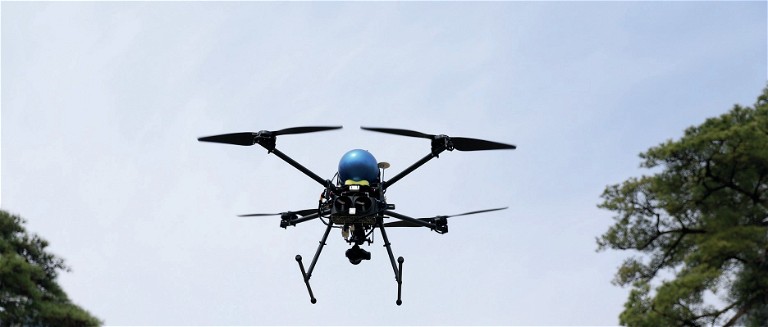
In 2019, an Intelligent Energy fuel cell and a MetaVista liquid hydrogen canister were combined to break a major endurance record
(Courtesy of Intelligent Energy)
Rotron for instance (first covered in our fourth issue, Autumn 2015, and revisited in the 49th) recently expressed interest in a hydrogen-burning engine, following Mazda’s success with creating a hydrogen Wankel.
Such changes are not limited to UAVs or automotive. For instance, the Mayflower autonomous ship (issue 42, February/March 2022) – the largest and best-known USV we have examined in detail – is powered by a biodiesel generator, minimising the harm it poses to the waters and sea life that so many organisations hope to study using it. And as mentioned in this issue’s USV Insight (see page 62), Demcon plans to use hydrogenated vegetable oils to power its next-generation 7 mUSV.
Perhaps most striking of the evolutions in UAV power is regarding hydrogen. Throughout the automotive world, one still need not look far to find critics of hydrogen-electric powertrains, but among uncrewed vehicles, hydrogen is widespread. We have featured nine UAV fuel cell companies from around the world over the past 6 years, and we know of many others.
A lot of uncrewed vehicles successfully run using proton exchange membrane (PEM) fuel cells to turn their hydrogen fuel into electric current. Cellula Robotics’ Solus-LR (issue 30, February/March 2020), Zephyr Flight Labs’ Z1 UAV (issue 36), and Auve Tech’s Iseauto autonomous taxi (issue 43, April/May 2022) for instance all operate using hydrogen fuel, with other users on the sea, air and land making headlines.
In future, as more fuel cell companies scale up production – as Toyota and Intelligent Energy (issue 24, February/March 2019) have – the reduced costs, easier availability and high efficiency of hydrogenelectric power will bed it in as a mainstream technology in autonomous systems.
Volumetric energy density remains a bottleneck for using hydrogen though, as overly large fuel tanks are problematic for any engineer to integrate. This will continue driving experiments with the cryogenic storage of liquid hydrogen, with Intelligent Energy achieving the world record for multi-copter flight in 2019 using such a solution, and storing compressed hydrogen at 700 bar or higher is expected to become common as regulations permit.
Energy-efficient futures
Necessity is the mother of invention, as the saying goes, and the world sorely needs more efficient vehicles. That is one reason why, despite the pace of innovation in fuel engines, many of the engine and hybrid power companies we periodically interview acknowledge that electric powertrains will one day completely replace IC ones. It might take a few decades or so, but eventually all uncrewed systems will be electric.
That is not to say however that key innovations in IC powertrains won’t carry over into the electrified world. Motor/ generators and power management systems for instance have taken much from IC-powered systems’ r&d, and this will no doubt filter into higher competitiveness in the production and performance of such components.
Further ahead, there are potentially huge gains to be made in recuperating or recycling heat. Whether IC, hybrid, hydrogen-electric or battery electric, every power system in an uncrewed vehicle generates heat. Even transistors, computers and other electronics contribute more and more to wasteful heat build-ups, although advances in processors and micro- or nano-electromechanics might mitigate that to some extent.

Intelligent swarming of autonomous vehicles will become an increasing focal point of GCS development, and of many industries and applications
(Courtesy of Autonodyne)
If microturbine developers can re-use the exhaust heat and push the capabilities of their powertrains, it stands to reason that other subsystem manufacturers will try similar innovations, be it with their own components or by working with OEMs to re-use heat across vehicle designs.
Innovations such as thermovoltaics for instance – which convert heat into electricity, much as photovoltaics do with light – could revolutionise energy efficiency across every part of the uncrewed systems market, with some groups actively working on thermovoltaic r&d specifically with future generations of uncrewed vehicles in mind.
Uncrewed systems everywhere
As manufacturing and deployment of uncrewed systems becomes more and more efficient, and regulations are agreed and passed, obstacles to the widespread use of UAVs, USVs, UGVs and UUVs will become fewer and further between.
As we have seen, AI is advancing rapidly, which is helping with the safety and capabilities of vehicles and robots, and the intelligence and reliability of swarms. This latter point is something of a sleeping giant with regards to what uncrewed vehicles in operation will look like in the decades ahead. The bulk of the GCS manufacturers we know are now very focused on how to enable one crew member to monitor and manage several uncrewed systems at once.
Part of this is down to user-friendly hardware and UI configurations; the other is AI software that enables vehicles to communicate and deliberate among themselves. Through improvements in the latter, uncrewed assets can flexibly change their formations, movements and strategies to achieve high-level objectives.
Some use cases for this are wellfounded, such as UGVs working in warehouses, UAVs providing wide-area mapping, and USVs and UUVs providing large-scale asset or border security.
Beyond those, industry experts point to many other ways that autonomous swarms could help the world we live in. Natural disasters for instance could be rapidly mapped and assessed for damage and casualties by uncrewed systems spread over hundreds of kilometres. Other systems can then provide aid packages quickly to victims, or even recover and evacuate injured people – as seen with vehicles such as Zelim’s Guardian USV (see page 62) and Rheinmetall’s Mission Master UGV.
But among all the trends we can anticipate for the future of this industry – be it scaling up manufacturing, wider fields of innovation or surging growth of uncrewed systems around us in our day-to-day lives – the common feature is growth. The autonomous vehicles world has grown enormously over the past 10 years, with new end-users appearing every day, and uncrewed vehicles and robots taking more and more industries by storm. It has all surpassed our founders’ wildest hopes, and quashed their fears many had that the bubble might burst before our eyes – so much so, that some now question if there is even a bubble that risks bursting at all.
In fact, with the pace of suppliers’ technological advances matching the ever-hungry demands of the uncrewed vehicle market, the only real bottleneck is people – that is, the ability of engineering teams and flight operations crews to attract the skilled personnel they need to get ahead of their competitors.
But as we have seen from these past 50 issues, and from the thousands of companies who have supported us along the way – to whom we give our unbounded thanks for their invaluable help – the uncrewed world has no shortage of inspiring stories with which to attract seasoned experts as well as new generations of talent.
For more of those stories, we invite you to continue the journey with us, and see what the next 10 years have in store.
As a final note though, anyone who cannot wait that long, and wants to know immediately what their next steps for high-quality employees or employment might be, should visit www.uncrewedengineeringjobs.com, the world’s only dedicated database with up-to-the-minute updates on available engineering and technical positions in companies dedicated to uncrewed systems and technologies.